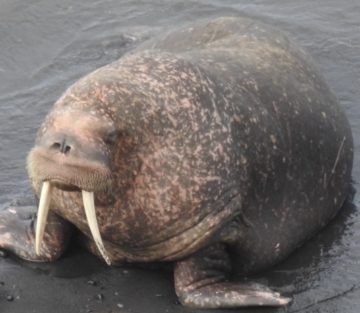by Leanne Ogasawara
Arriving early for our flight, we found the other six passengers checked-in and congregating around an old topographical map of Alaska hanging on the wall in the small airline office.
“Does anyone know where exactly we are going?” asked a woman, breaking the silence.
We all edged forward, squinting at the map. It was July. But cold enough to wear my puffy coat.
“Somewhere south of Port Heiden….” Someone ventured.
 My eyes traced the 1500-mile-long arc of the Aleutian Range. Running down the Alaskan Peninsula, the land on either side of the mountains is mainly wilderness and wildlife refuges. Even more astonishing was the complete absence of roads. As a Californian that is hard to fathom.
My eyes traced the 1500-mile-long arc of the Aleutian Range. Running down the Alaskan Peninsula, the land on either side of the mountains is mainly wilderness and wildlife refuges. Even more astonishing was the complete absence of roads. As a Californian that is hard to fathom.
No roads.
Instead of cars, they have grizzly bears. One of the highest populations anywhere in the world, in fact. But we were not going for the bears. We were traveling to this remote location because it happens to be one of the best places in the world to see a walrus haul-out.
It was time to board our plane. The Beech 99 had seen better days. As the smell of smoked salmon filled the cabin, someone mentioned the lack of airsick bags. At least we were leaving on time.
Looking across the aisle at my husband, I saw his eyes were gleaming. This is a guy who never once questioned why we were spending all our money to go to Alaska to see walruses. He was up for anything.
Smiling over at him, I thought he had never looked happier.
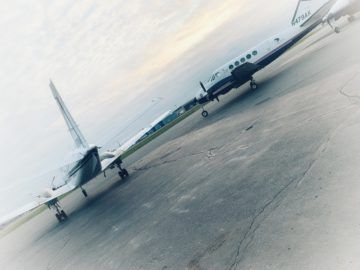 2.
2.
Walruses are rarely found in deep waters. Bottom-feeders, they suck up clams and worms on the ocean floor. It’s hard to imagine how many of those small invertebrates a walrus must ingest to maintain their marvelous stores of blubber. They must eat all day! And yet, these highly social creatures spend enormous amounts of time flopped onto ice floes and along sandy beaches, where they rest and raise their young.
While females give birth out on the ice, great herds of male walruses congregate on coastlines to prepare for winter. They are especially fond of beaches against bluffs. The hill at their backs makes them feel safe from predators, scientists suggest. So too does sticking together in large groups, where they roll around against each other, grunting and whistling. Sometimes sparring, with those gleaming tusks reflecting the long summer sunlight.
The sole-surviving member of the Odobenidae Family, the fossil record tells a story of many kinds of walrus-like creatures in the distant past. What a sight that must have been. Reminiscent of Jabba the Hutt, the walruses of today’s world seem hardly to belong to our planet. Improbable on land, they appear like some phantasmagoric creature from a medieval bestiary come to life.
And is it just my imagination that some of them bear a striking resemblance to Renaissance astronomer Tycho Brahe?
 3.
3.
During our three weeks in Alaska, we were also only rarely on a sewage system. Yes, Alaska really embraces its outhouses!
Energy was also often off-grid, ranging from 100% solar and hydro to diesel and kerosene generators.
It’s not just the lack of roads that makes the state of Alaska’s infrastructure report card so bad.
What roads Alaska does have are not maintained very well. But this is not necessarily a bad thing, since as soon as you build a road, you are opening the floodgates to development in the form of big box stores, amazon trucks, vast tracts of monocrop agriculture and industrial animal farming.
“Roads are always a slippery slope,” said a brilliant ecologist we met in Denali National Park, because once they are there, it is hard to get rid of them.”
 How true that is.
How true that is.
Last spring, we visited a large ranch in West Texas that was being turned back to its natural state. It was a pet project of a wealthy man who owns around 40,000 acres fifteen miles north of the border. I learned that returning the land to its wild state is not a matter of just doing nothing—but rather is a tremendously expensive endeavor of removing hundreds of years of invasive species and damage to the ecosystem—much of that damage having arrived by roads.
4
The two-and-a-half-hour flight down the peninsula took us over dozens of semi-active volcanoes.
Some were smoking in the snow.
The flight ended suddenly when a runway appeared out of nowhere. And there was the lodge, at the foot of Mount Veniaminof. Named after Russian Saint Innocent, a priest who had come to Unalaska in the early-19th century, puffing Mount Veniaminof is one of the most active volcanoes in the Aleutian Range. Located in the northern part of the ring of fire, this is one of the most seismically active places in the world. As demonstration of this, an 8.2 earthquake occurred on July 29, 2021 not far from this location, out at sea, the day we left the lodge.
The lodge was our base camp. But from there, it was still another thirty-minute trip by bush plane to a beach five or so miles out from the haul-out site.
 Symptoms of climate change have already arrived to the extreme north and disappearing sea ice is now the biggest threat that these animals face. With fewer and fewer haul-out sites, some mega-haul-outs are happening on beaches not big enough to support so many animals, who pile up on top of each other. Since walruses spook easily, the sound of a plane could start a walrus stampede causing many animal deaths.
Symptoms of climate change have already arrived to the extreme north and disappearing sea ice is now the biggest threat that these animals face. With fewer and fewer haul-out sites, some mega-haul-outs are happening on beaches not big enough to support so many animals, who pile up on top of each other. Since walruses spook easily, the sound of a plane could start a walrus stampede causing many animal deaths.
So, we landed the plane on a black sand beach six miles away, on the Bering Sea, and set out on foot—eight of us—across the tundra.
The brilliant green of the rolling terrain was like a great inland ocean. From the air the marshy grasslands went on and on– only broken up by glistening braided rivers and kettle ponds of all sizes, the pristine water reflecting the clouds above.
We landed on the black sand beach –that just never got old—not far from a dead walrus, whose body had washed to shore. There were also whale vertebrae shining white against the black sand and kittiwakes flying in the thousands, near their nests against the cliffs.
“That is where we are headed,” said our guide, Hunter.
We looked toward the cliffs. They seemed so close– but it would take hours to cover the ground. We made our way quietly. By this time, my husband had refused to take his phone off airplane mode –“I’m on vacation,” he said for the first time since I met him. He had fallen in love with everything in Alaska—even the outhouses, which he intentionally sought out whenever he had to go to the bathroom.
 By this time, we had been in Alaska nearly three weeks, and he showed no sign of ever wanting to go home again. He seemed like a different man with his eyes bright at the prospect of seeing more grizzlies.
By this time, we had been in Alaska nearly three weeks, and he showed no sign of ever wanting to go home again. He seemed like a different man with his eyes bright at the prospect of seeing more grizzlies.
5.
Before he became famous for his Middle Earth novels, J.R.R Tolkien spent two years working in the offices of the Oxford English Dictionary. Assigned the W entries between “waggle” to “warlock,” Tolkien was particularly challenged by “walrus.” He found that by 1655, the English word we use today had very tentatively come into the language from the Dutch walrus –a compound of wal (“whale”) and ros (“horse”) —And that this Dutch word probably originated in an Old Norse word rosmhvalr (also meaning horse-whale), which later became hvalross (whale-horse) in modern Norwegian.
Because not much was known about animals that lived in the sea, Europeans of the past liked to think of marine creatures in imagined pairs with a terrestrial counterpart. So, we have sea lions and elephant seals, catfish and seahorses. I didn’t know this, but seals used to be referred to as sea dogs—and a porpoise was a sea pig. It is not clear why people thought a walrus was like a horse, but it was probably derived from the sounds that walruses make, rather than their appearance, since walruses don’t really resemble horses.
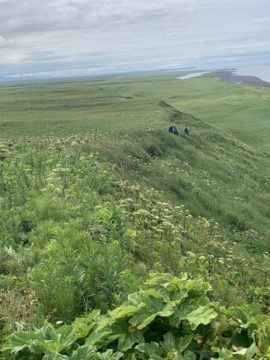 In Chinese, the characters used for writing walrus mean Sea Elephant 海象, which, given their tusks, I think is better.
In Chinese, the characters used for writing walrus mean Sea Elephant 海象, which, given their tusks, I think is better.
Whatever the reason, “horse whale” was used in English until the early 19th century interchangeably with morse, an archaic word borrowed from the Slavic languages. Tolkien traces the English word morse to морж (morž) in Russian, mursu in Finnish, morša in Northern Saami, and morse in French. This is where Linnaeas got the scientific (Latin) species name for the animal: rosmarus.
Odobenus rosmarus which is the family and species name for walrus loosely translates as ‘the rosy sea tooth-walker.’ This is not a bad term for the animal, since walruses do, in fact, appear pink in warm weather, when their circulation increases to help cool their bodies down.
They can even look as white as their tusks when they first emerge from cold waters.
And what of those luminous tusks?
Well, they are overgrown upper canine teeth, mainly used for displays—though they do on occasion use their tusks to help haul their bodies onto the ice.
Walruses have long been hunted for food and hides, and their tusks were used to make carvings. In the 17th century, Europeans also began hunting them. This was for oil which they needed as a replacement for that found in bowhead whales, which had all but disappeared by then. Not surprisingly, over-hunting by Europeans led to the near extinction of walruses by the nineteenth century.
So precarious had their numbers become by 1941, that the US government banned their hunting—except for subsistence use by arctic peoples.
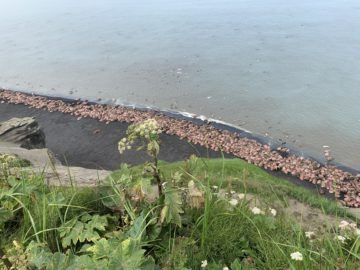 6.
6.
After several hours of walking, Hunter warned us to do nothing to disturb the animals. They spook very easily, and it could be disastrous. We were to crouch low in the grass and observe from a distance way up from the top of Hell’s Bluff.
He had warned us that we would smell them before we saw them. The wind coming off the water had carried the “walrus stinky” straight to our nostrils as we rounded the top he hill. And accompanying that smell was the alarming sound of very loud grunting.
And was that snoring, farting, and sneezing in the mix?
Making our way to the edge, we gazed down on what was a writhing hive of activity. A thousand bulls hauled out and flopped on the beach, flipper to head and head to flipper—like the biggest dog pile in the world! Constantly adjusting their positions, one bull annoying the walrus next to him. This would ignite new altercations, when sometimes tusks were brandished.
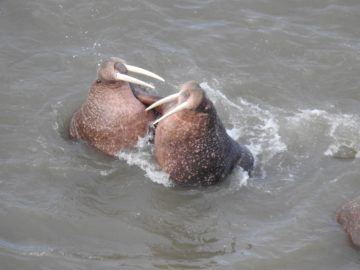 The sea was also filled with activity. Walruses swimming with great eagles, shearwaters, and kittiwakes above. I have never, not even in Southern Africa, seen such a wondrous vision as those beautiful creatures hauled out on the black sand beach.
The sea was also filled with activity. Walruses swimming with great eagles, shearwaters, and kittiwakes above. I have never, not even in Southern Africa, seen such a wondrous vision as those beautiful creatures hauled out on the black sand beach.
It was a moment of pure joy.
Had I at last found my slice of heaven on earth?
7.
On our trip, we met many people, who had travelled to Alaska for the first time, and never left. It had simply grabbed them hard around their hearts. Perhaps if we had been younger, we would have stayed…?
As we crouched in the tall grass, I thought of “the peace of wild things” that poet Wendell Berry wrote about. The way a person can feel truly free “resting in the grace of the world.”
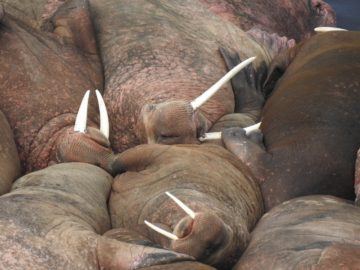 I had forgotten –maybe I never really knew in the first place?–what it is like to live among fantastic creatures and to be a part of a place; to give oneself over to the peace of wild things. In today’s world, so many of us have lost our connection to the land. We have forgotten that we are part of a community, not just of our fellow human beings, but an interconnected ecosystem of fish and birds; oceans and forests.
I had forgotten –maybe I never really knew in the first place?–what it is like to live among fantastic creatures and to be a part of a place; to give oneself over to the peace of wild things. In today’s world, so many of us have lost our connection to the land. We have forgotten that we are part of a community, not just of our fellow human beings, but an interconnected ecosystem of fish and birds; oceans and forests.
The guides we met in Alaska knew every flower name, every insect– and they could tell you all the many ways the world around them changes month by month. When water turns to ice. When the second sockeye run will start and when the salmon berries will be ripe for picking. And how to turn those berries into jam.
I could hardly imagine having that kind of knowledge back home. Could I name the thirty most common birds in my neighborhood and explain their basic patterns month-to-month? Which birds migrate and to where? And what about all the flowers and trees? Could I even pick out the native species?
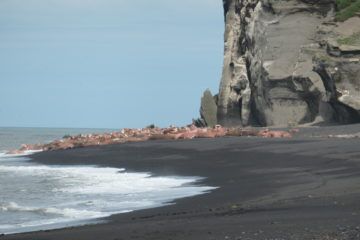 Doesn’t knowing involve a kind of attention and care?
Doesn’t knowing involve a kind of attention and care?
You’ve got to be tough to live in Alaska; for in a wild place there is always the threat of real danger. Everything is hungry. Watching walruses is to risk a stampede, like fishing for sockeye means sharing the river with hungry bears. Bushwhacking through the tangled alder is to risk startling a moose. As an anxious person, Alaska was always outside my comfort zone. And yet, breathing that clean air— even the air is wild in Alaska— I understood how much I had been longing for something I hadn’t realized I was missing.
Though we could not stay, we will return; for each day we spend in the circumscribed, man-made world we all navigate, a part of us will be walking across the tundra, toward the wild Bering Sea, in search of magic.
++
The Peace of Wild Things by Wendell Berry
When despair for the world grows in me
and I wake in the night at the least sound
in fear of what my life and my children’s lives may be,
I go and lie down where the wood drake
rests in his beauty on the water, and the great heron feeds.
I come into the peace of wild things
who do not tax their lives with forethought
of grief. I come into the presence of still water.
